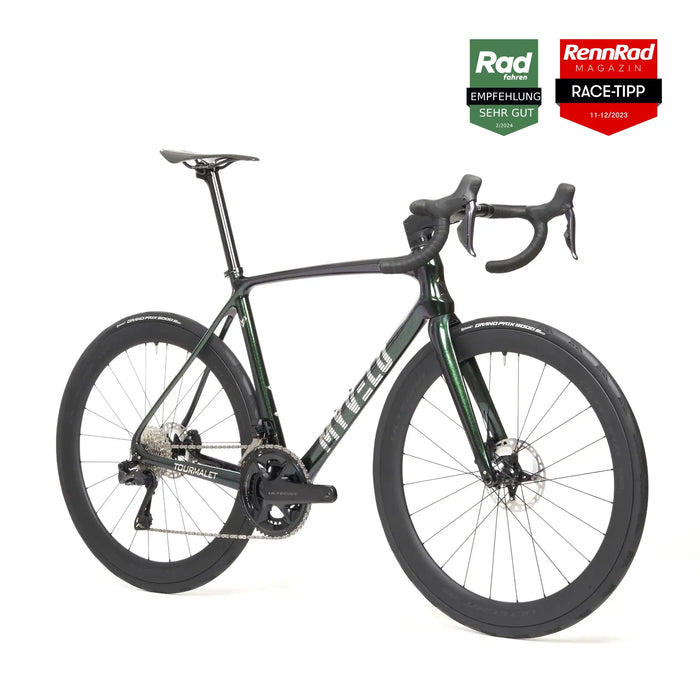
Tourmalet road bike
incl. FREE shipping & free returns

For many road cyclists, the Stelvio Pass is more than just a mountain pass—it's an icon, a must-do on the list of epic challenges, and a place that blurs the line between passion and madness. With its 48 hairpin bends on the northern ramp and an elevation of 2,757 meters, the Stelvio is the second-highest paved pass in the Alps and an unparalleled adventure.
Von Vincent Augustin |
3 minutes read time

The pass connects the Italian Valtellina with the South Tyrolean Vinschgau and impresses not only with its sheer height, but also with the magnificent landscape that unfolds along the route.
The Stelvio has a long tradition in cycling and has been a decisive stage of the Giro d'Italia several times. Since its first crossing at the 1953 Giro, where Fausto Coppi launched a legendary attack, the Stelvio has been considered a touchstone for professionals and amateurs alike. The combination of elevation, thin air, and the challenge of the switchbacks makes this pass a true test.
There are three main routes to climb the Stelvio:
The Stelvio not only demands everything from your road bike, but also from you. Good preparation is key:
The Passo dello Stelvio demands a road bike that's both lightweight and robust. An optimal setup includes a 52-36 gear ratio up front and an 11-34 cassette at the rear—this allows you to efficiently tackle the steep sections while still building speed on the flatter sections. Reliable brakes are essential for the technically demanding descents. A road bike like the MYVELO Tourmalet, designed for demanding mountain tours, offers exactly the balance of performance, comfort, and control you need for this epic challenge.
At MYVELO we are so enthusiastic about the Stelvio that we also named one of our E-MTB fullys after it.

Once at the top, you'll be rewarded with a view that's second to none. The panorama stretches all the way to the peaks of the Ortler, and the switchbacks you've conquered seem almost surreal from a bird's eye view. The descent is no less exciting and requires full concentration – but here, too, you'll feel the fascination of the Stelvio.
The Stelvio Pass is not only a test of your legs, but also of your mind. The combination of physical exertion, scenic beauty, and the history of this pass makes every ride unforgettable. Whether you plan to conquer it once in your life or return regularly, the Stelvio will captivate you time and time again.
Are you planning your tour to the Stelvio? Which route appeals to you most? Share your experiences and tips in the comments!

Wer regelmäßig mit dem Rennrad unterwegs ist, kennt das Ritual: Nach einer langen Ausfahrt oder vor einem knackigen Intervalltraining führt kein Weg am Espresso vorbei. Ob in der italienischen Bar an der Strecke, auf dem Marktplatz nach dem Sonntagstraining oder zuhause aus der Siebträgermaschine – der Espresso ist fester Bestandteil der Rennradkultur. Doch was steckt hinter dieser Verbindung aus Koffein, Stil und Leistung?

Wer an Rennradfahren denkt, hat oft Bilder von durchtrainierten Beinen, kraftvollen Antritten und aerodynamischer Haltung im Kopf. Doch ein Muskel spielt eine unterschätzte, aber entscheidende Rolle: der Beckenboden. Er ist nicht nur für Stabilität und Körperkontrolle wichtig, sondern auch für Komfort, Leistungsfähigkeit – und die langfristige Gesundheit auf dem Rad.

Die Auswahl an Fahrrädern war noch nie so groß wie heute. Rennrad, Mountainbike oder doch ein Gravel Bike? Jedes dieser Bikes hat seinen eigenen Charakter, seine Stärken und idealen Einsatzbereiche. Doch wo liegen die Unterschiede – und welches Rad passt am besten zu Dir und Deinem Fahrstil? In diesem Artikel erfährst Du, was die drei Bike-Typen auszeichnet, welche Vor- und Nachteile sie haben und worauf Du bei der Entscheidung achten solltest.